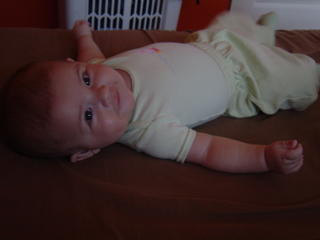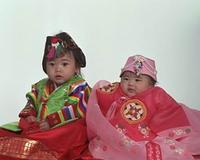
Today's the day! Astrid is officially 100 days old. Can you tell I'm excited?
I forgot to mention in my last post that the Korean culture includes the months the baby spent in the womb when calculating age. 100 days after the birth is approximately 1 year from conception. So in a sense, this is the baby's first birthday. The Korean word for it is "Paek il" and it's defined as "the celebration of baby's first 100 days in which money and other gifts are given to parents for the baby. " Thank goodness for the internet as I found more information and a cute photo. (See below.)
 No, this isn't a photo of Astrid. But the younger of the two girls in the photo is also celebrating her 100 days birthday, and she and her sister are both wearing Korean hamboks.
No, this isn't a photo of Astrid. But the younger of the two girls in the photo is also celebrating her 100 days birthday, and she and her sister are both wearing Korean hamboks.There are special kinds of hambok for the babies to wear. For example, a hambok with rainbow colored sleeves. Girls wear an overgarment which resembles the ceremonial robes of the ancient court ladies. In addition to that, a boy will also be dressed in a vest and a hood.
This I find particularly funny because I had a hood and a vest which means my mom dressed me like a boy. She finally got her wish to have a boy when my brother came along and he got to wear my outfit on his 100 days birthday too.
After the baby is properly dressed, they are seated in front of a large table. And on the table you will find different types of food and fruits. You will also find threads, books, calligraphy brushes, ink, money, arrows or daggers, rice, needles, and scissors. After the baby is seated with the objects in front of him/her, everyone attending the ceremony waits patiently to see which object the baby will grab. It is believed that the object which is picked up first will foretell the baby's future. For example, if the baby picks up a calligraphy brush or a book, then it is believed that he/she will be a scholar. If he picks up an arrow or a dagger, he/she will be a soldier. Finally if the baby picks up the money or rice, it is believed that he/she well be blessed with wealth. If the thread is chosen, it is believed that the baby will have a long life. Guests usually bring gift of money, clothes or gold rings. After the ceremony, the departing guests are given rice cakes. Here are some quirky facts about the Korean tradition:
Here are some quirky facts about the Korean tradition:
1) In the old days, there was significantly high infant mortality rates and a baby surviving the first 100 days had a significantly higher change for survival into childhood and beyond.
No wonder there aren't any newborn photos of me. I guess it was bad luck to take photographs of your baby before it was 100 days old.
2) Traditionally, for the first 100 days, only very close family are to come in contact with the baby and the baby does not go outside at all.
Well we nixed that one when Astrid was just 5 days old. We took her to San Francisco with us where Uwe was attending a conference. Lots of contact with strangers, including the valet, maid, room service attendant, and all the people in the restaurant where we had dinner in the hotel lobby. She loved it. During the day she had the whole bed with high thread count linens to herself with a view out the big bay window overlooking San Francisco. Who can beat that? She's a really good traveler already and we hope that our trip instilled some Wanderlust in her. The world is full of exciting things to see and interesting people and life's too short to spend it hiding inside and being afraid of the world outside. That's my take anyway. I'm sure Astrid will grow up hearing this story a thousand times, "When you were just 5 days old..."
3) When a baby girl is born, the birth is announced by hanging a white cloth (or a string of peppers for a baby boy) at the front door of the house. It tells visitors that there is a new baby in the house and it is respectful to refrain from visiting in fear of the baby's health.
I guess if we would have put up a flag or something announcing "Baby Girl Arrived" it would have kept the neighbors from questioning me, "Whatcha got there? A baby? Did you adopt? Oh it's yours. We didn't even know you were pregnant." It's not like I hid the fact that I was pregnant. I started to really show when I was 6 months pregnant. And I didn't hide away in the house either. I worked right up until I had Astrid. So go figure!
4) Baby wears only white clothing during the first 100 days, because white cotton clothes are the easiest to sterilize by boiling. On the 100th day the baby wears colorful clothes for the first time and other adults can hold her.
In Astrid's case, she wore clothes that were white, yellow, green, blue and pink. She even has one black outfit (the Smokey and the Bandit one). Only white? Reminds me of a coworker's comment. We were debating the color of something in the office and some thought it was violet, and others fuchsia. One coworker threw in his opinion that it was just red, to which another coworker commented, "Oh you poor man. You must have only had the 12 Crayola crayon pack when you were a kid."
5) On the morning of the 100th day of the baby's birth, either the mother or the grandmother (of the baby's parents) prepares rice, seaweed soup, and other white items and prays to the ancestors to bless the child with long life and good fortunes. Then the rice and the soup is fed to the birthmother.
I can cook rice with my handy dandy Korean rice cooker, but I have no clue how to make seaweed soup. I used to ask my mom to show me how but it was always "a little of this, a little of that" and I'd go away with no idea how to make it. I love seaweed soup though. Maybe I'll have some tonight when we go to dinner at a Korean restaurant to celebrate.
It's such an important celebration in the Korean culture and I'm sad that I can't share this day with my mom. *flashback to wedding planning* Having a Korean mother I thought she would want me to include some Korean traditions in my wedding but she surprised me by saying "Why do you want to do that? It's too much trouble. Just do it the American way." So in this respect, I'm doing it the "American way" again by going to a Korean restaurant.
6) Typically, the baby's hair is cut and tied in a lock and kept in safety until the baby comes of age (age of majority). The hair is returned to the grown child to remind her of the eternal love of her parents. The child would keep the hair as a reminder of the thanks to the parents bringing her into life.
There isn't enough hair to cut and make a lock out of. But did you see the photo of the Korean kid above? Underneath that hat she had a full head of really thick black hair. I guess this one doesn't apply if you have a kid that's not 100% Korean. Don't feel bad Astrid, mommy didn't have that much hair either (me not being 100% Korean either) and look at my hair now..every time I go to the hair salon the stylist comments, "Wow, you've got SO much hair."

7) Prepared white and other rice cakes are shared with as many people as possible to spread the blessing. People who share the rice cakes present gifts to wish happiness and long life.
Ah catering and a party. Will have to wait until Astrid's 1st American birthday. *flashback to engagement party* Me being American (Korean/German ancestry), and Uwe being German, we thought we might do a Korean/German shindig...as in Korean food and German beer, but in the end we served Mexican food at our engagement party. The margaritas were flowing and we did the German traditional Polterabend (friends and family bring ceramic dishes, cups, etc. to break by throwing them up against a wall, and together the bride and groom-to-be use a broom and sweep up the mess together. It represents doing away with evil spirits/bad luck/the past and ushering in good times, and working together to make a happy future for each other. Very nice tradition. I was whole heartedly for it.) So in the end the food really didn't really matter. Plus everyone loves Mexican food. And it was more about celebrating with friends and family and having everyone's blessing and well wishes. Same goes for the birth of a child and birthdays. It's really all about celebrating that child's life regardless if there's Korean BBQ or turkey burgers and hot dogs being served.
8) Although the baby already has been given a name for the records, adults may see the baby for the first time and give her a baby name as a sign of adoration. Typically this baby name is used only inside the house.
Uwe already has a few nicknames for Astrid but none that we can continue to call her when she's older and understands what they mean. Is that the same thing? Okay maybe we need to find an appropriate nickname for Astrid that is a true sign of adoration.
Happy Birthday sweetheart!

3 comments:
Happy Happy 100th day after birth celebration Astrid !!!
It is amazing, those different things that different cultures come up with to have an excuse to party. E.g. in Japan the first celebration is May 5th, kid's day .. the first one is celebrated big!
And now I will say the most annoying thing parents ever say: "Can you believe its already been 100 days?" And of course, I love that she went to SF when she was five days old. Let the wandering begin early!
Hi there,
I stumbled upon your blog after searching for Polterabend. Like you, I'm Korean-American. My fiance is German, originally from Berlin. I think it would be fun to break dishes on the night before the wedding...but we live in a condo with pretty strict homeowners' rules. I'm wondering, where were you were able to break dishes safely without leaving damage to a wall? Did you do it outside? What type of wall did you use?
- S. Im
Post a Comment